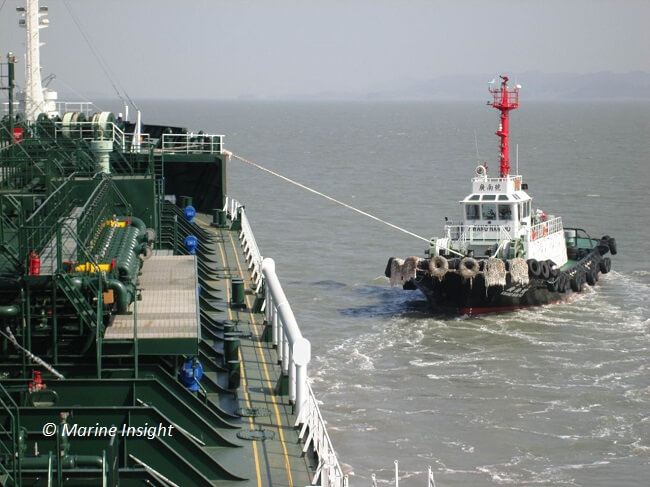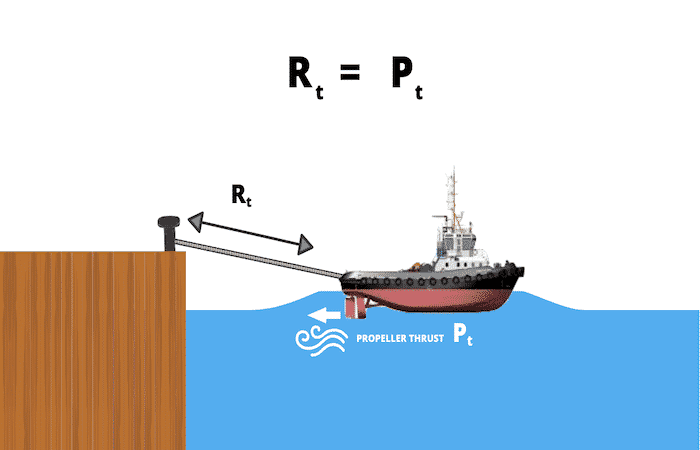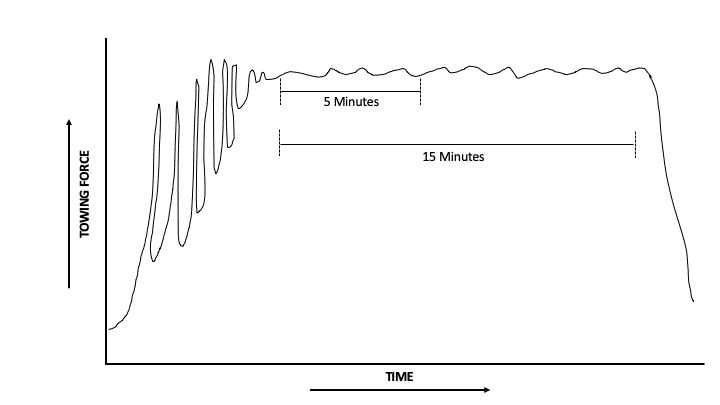Bollard Pull is a measure of the pulling power of a vessel, comparable to the horsepower rating of conventional vehicle engines. It can be defined as the thrust that is developed by the propulsion systems of any vessel when it has a zero speed in the forward direction.
Bollard pull is calculated by connecting a pier bollard with a towing mechanism on the vessel and computing the force or tension developed in the connection using a load cell or similar component.
Bollards are short, stocky structures generally built out of metal, used on piers or docks to help moor the vessel to the port, by anchoring the tow lines. In general, people are more familiar with bollards as being found in major cities to prevent car-ramming incidents in public places.

The bollard pull is similar in principle to the drawbar pull (coupling strength used between trailers and trucks) used on tractors, trucks, trailer-haulers, etc. to measure their ability to pull heavy loads or trailers.
The bollard pull value is generally required for vessels such as tugs and is recorded in kilonewtons (denoted as kN) or other units of force such as short tons (stf) or tonnes of force (tf). Every tug or vessel that is required to pull an additional load other than its weight requires a Bollard Pull certification from one of the internationally accepted classification societies.
Societies such as the American Bureau of Shipping (ABS), Indian Register of Shipping (IRS), Bureau Veritas (BV), etc. supply vessels with their certification on successful completion of the bollard pull test.
Related Read: Watch: ALP Striker’s Bollard Pull Testing
Importance of Bollard Pull
Similar to horsepower used on-road vehicles, waterborne vessels also have a common measurement unit of power that can be universally understood.
Unlike conventional road transport where the torque and speed relations match, tugs and such vessels that have to haul enormous loads on the water are required to operate in low-speed conditions.
Thus, while their speed may appear to be extremely low, the total torque and power developed by their thrusters and propellers would be significant. Through a study of methods used to measure pulling power, the concept of bollard pull was developed.
The reason bollard pull records the force at zero speed in the forward direction is to ensure that the tug or support craft can hold a ship steady under its own power when the towed ship exerts its own thrust in the reverse direction. In ports, to guide incoming vessels, tugs are deployed to aid ships in navigating.
However, since the larger ship moves under its own propulsion, and might not be able to quickly alter course in the event of a collision, tugs must be able to immediately stall the motion of the ship and then correct its course. This requires a near-maximum thrust to be developed in the propulsion system of the vessel. The bollard pull provides operators and manufacturers with a quantifiable value of the force exerted by the tug in such situations.
Related Read: A Detailed Explanation of How a Ship is Manoeuvered to a Port
Unscrupulous tug operators are often able to manipulate horsepower ratings on their vessels without any repercussions, since it is difficult to actually verify that the value noted down in the manuals of the vessel is accurate, especially for waterborne crafts.

In addition, manufacturers of such vessels are also able to market their craft by altering the horsepower ratings mentioned for a particular vessel. Bollard pull is an internationally recognized means to measure the thrust developed by the propellers and nozzle system on vessels. Most tugs and support vessels these days are required to have this certification to operate.
Another reason for implementing bollard pull is to efficiently manage the logistics involved in the shipping industry. Heavy-duty vessels that are used to move and guide large loads, tankers and ships through a port or busy channel must be aware of the actual amount of load that they can pull.
In addition, this determines the speed of the tug and the time it takes to move a load from different points, which is critical in the logistics planning and the management of a port. Thus, bollard pull provides authorities with an accurate figure about the capabilities of the tug. It is essential that the testing of this value is carried out at zero forward speed to ensure this accuracy.
An upcoming field of use of bollard pull is the testing of Anchor Handling Tug Supply vessels (AHTS) used to tow enormous semi-submersible structures such as oil rigs.
These often need to be moved to new locations based on the sub-surface oil deposits. Instead of building rigs attached physically to the sea bed, modern technology has enabled rigs to remain afloat thanks to partially floating columns. Such rigs are called semi-submersibles and are commonly found in all the major oil-producing regions around the world.
To keep the rig in a constant location instead of floating away, heavy anchors weigh it down on to the seafloor. When a new deployment is required, AHTS vessels tow these massive rigs using a connector towline.
Since these structures are often much larger than conventional ships, the pulling prowess of these tugs is of utmost importance. In addition, their speed and performance under such loads must also be recorded for the purpose of logistics optimization.
How is Bollard Pull measured?
To measure the pulling capacity of a vessel, a bollard pull test is used to classify tugs on their towing ability. Experimentally, the test is carried out by using a bollard to anchor a vessel to the pier. Then, without slack in the connecting link, the vessel is required to propel itself at maximum thrust.
Since the vessel is technically moored, it has zero forward speed, and the tension built up in the connecting towline indicates the total thrust developed by the vessel propellers.

To carry out the bollard pull test, ideal conditions are required to be able to accurately gauge the pulling power. Some of these conditions include:
- Waters without tides or any disturbances,
- Sufficient clearance on all three directions of motion,
- Even draft of the vessel along its length,
- Unobstructed propeller wake and stream.
However, obtaining such ideal conditions is practically impossible. Hence, the bollard pull value assigned to vessels is generally not 100 % accurate, and a tolerance value of error must be kept in mind while analyzing these values. Moreover, the pulling power can vary depending on the particular sailing conditions faced by the vessel.
In such circumstances, computational simulations output accurate numerical values that can be used for preliminary studies. However, such methods are expensive and facilities for carrying out such tests are difficult to set up. Hence, the bollard pull test is experimentally carried out with a factor of error and then compared with basic simulation results.
When constructing a fleet of vessels with similar pulling characteristics, it is more feasible to carry out computational studies since their application will be more extensive.
Due to the sensitivity of the trial, minute parameters such as the salinity of the water must be kept constant. The main function of the propeller is to move a certain mass of water in a unit time, that gives the vessel the required thrust.
However, since the mass of water displaced by the propeller blades can vary with the density of water (which is influenced by its salinity), keeping a constant value is important. This can be achieved by ensuring that the test is carried out in a single location, and by utilizing the correct values of survey results on the water salinity and density.
To achieve accurate readings without major fluctuations, the test is often carried out for a period of ten minutes, or until any oscillations and unsteady movements are settled. However, once the test is carried out at maximum thrust condition, further testing is not to be until the surrounding water has settled down.
The average of physical quantities such as thrust, tension build-up, speed, etc. are recorded over the duration of the experiment and then entered into the vessel manuals, where such important parameters regarding the performance of the vessel are stored.

In addition, any power provided by other propulsion systems such as electronically actuated thrusters must be recorded separately in the manuals under the classification of Hybrid Bollard Pull (HPB). Vessels are often able to operate under these hybrid conditions due to innovation in green technology, and the HBP provides a measure of this extra thrust.
Bollard Pull Calculations
For any physical process, there is always some energy lost to the surroundings, which can reduce the expected output. In the case of the bollard test, some amount of propulsion energy is lost in the form of heat, friction or tension losses.
Thus, an efficiency factor is introduced to give a more accurate value of the expected power. We can calculate the actual pulling force of the tug as given below:
Actual pulling force (in kN) = (Bollard Pull Force in kN) x (Efficiency Factor)
This efficiency factor ranges between 0 to 1, with 1 indicating a 100% efficiency of the set up, and 0 indicating a complete loss of power.
The basic physics behind the bollard pull is that the force exerted by the tug on a ship must be larger than the forces holding the vessel back, namely resistive or counter forces. This includes friction, wave and wind resistance.
Friction arises between the hull of the vessel and the surrounding water, due to current moving in a direction opposite to the expected direction of motion.
Related Read:Various Methods Used for Evaluating Ship’s Resistance
Wave resistance arises due to the oscillations set up by waves, or slamming effects created at the bow. This significantly affects the movement of any vessel, since this resistance must be overcome.
Wind forces come into picture when the wind is against the sail-area of the vessel, which can hamper forward movement. Along with these external forces, inherent resistance of the hull also comes into picture. This hull resistance is calculated as given below:
Resistive force (R) = (0.5) x (Density of water) x (Wetted surface area of the hull) x (Velocity of the vessel)2
Thus, the minimum force that the tug must exert to initiate movement in the towed vessel is given as:

However, owing to various losses, the efficiency factor comes into focus, and the equation can be rewritten as:

Now, any tug pulling a load behind it must factor in the thrust it requires to move not only the towed object but also to overcome its own resistive forces. Thus, the bollard pull value can be given as:
Available Bollard Pull = (Bollard Pull measured) – (Force utilized by the tug)
Here, we can observe the importance of maintaining a zero ahead speed during the experiment. At such conditions, the force used by the tug to overcome its own resistance amounts to zero. Thus, the entirety of the bollard pull force can be utilized for towing any vessels linked to the tug.
On the other hand, under top speed conditions, the entire bollard pull will counter the resistive forces, and no force will be reserved for towing the additional load. Since tugs cannot operate under zero-speed conditions in ports and harbors, an acceptable range of speeds must be calculated, so that the tug can reserve a portion of its bollard pull force for towing any additional load.
Using calculations or predictive analysis, a full range of accepted speed values can be computed, based on the force required to tow a vessel connected to the tug.
Then, based on a case by case scenario, tug operators can maintain a certain optimum speed so that the power required to tow the specified vessel is provided to the tugs propulsion systems.
By refining and optimizing the design of tug vessels, lesser bollard pull can be utilized in overcoming its own resistive forces, and can instead be diverted for the towing operation.
How Can the Bollard Pull Value be Increased?
As vessels and ships get bigger owing to the larger space demands and higher tonnage of goods and passengers moved across the globe by the shipping industry, the pulling power of tugs must also increase to match the size of their load. To do so, innovation in the propulsion and guidance systems are a must.
The most common addition to conventional propellers is a nozzle casing around the propeller blades. The insides of the nozzle casing are shaped in a manner that optimizes the outflow of water, similar to the structure of a hydrofoil. This design drastically increases the thrust provided by these blades, especially under low speeds and high load conditions.
However, this comes at the cost of propulsion at high speeds. Fortunately, tugs and ancillary vessels only operate at low speeds, and this does not present a major hurdle. This style of the propulsion system is composed of two main components – the conventional propeller shaft and blades, and an additional shroud or casing.
Related Read: Procedure For Ship Propeller Renewal
For vessels with multiple propellers (due to increased load conditions or higher speed requirements), all blade systems are provided with the shroud, to prevent any hydrodynamic imbalances. These vessels have a higher power requirement but are more stable due to the thrust balance across the center plane of the vessel.
Sometimes, the rudder and navigation equipment are integrated with the entire ducted propeller. By implementing such a system, the overall bollard pull can be increased by nearly 30%.
However, the major disadvantages with this type of propulsion system is the lower thrust at high speed and the increased risk of cavitation. Cavitation is the release of bubbles around propeller blades due to a large pressure difference created by the rotating blades.
The high-speed rotation drags the surrounding water particles and creates a low-pressure region, which superheats the water around the propeller blades to boiling temperature. This boiling effect creates bubbles around the propeller systems, and this phenomenon is known as cavitation.
The reason why it is undesirable is that it saps valuable energy from the propulsion systems, that would have been used instead for increased thrust and power to the vessel.
Possible Sources of Error
In an experiment fraught with parameters beyond the control of the investigation team, extreme care must be taken while conducting it. Common sources of error that crop up during the testing process include ground and wall effects, winds and tides, uneven trim, slack towline etc.
When propelling the vessel, it is important to ensure that the surrounding water flow is unobstructed by any surfaces. This includes checking that the draft of the vessel is sufficient, sides are free from debris or other floating objects, and that the rear of the vessel is sufficiently far away from the pier or mounted bollard.
The reason for keeping the rear of the vessel apart is to allow the propeller wake to fully develop. The wake of a propeller is the flow that emerges away from the thrusters, and moves behind the vessel.
For large ships or tankers, it is characterized by a V-shaped flow behind the ship. If this flow is obstructed due to the proximity of the vessel to the pier walls, recirculation of propeller flow is possible.
This means that the wake coming out from the propulsion system reflects of the obstacle, and sets up a series of oscillating waves that rock the vessel being tested.
As the vessel attempts to throttle even faster to stay steady, the frequency of oscillations can rapidly increase, resulting in damage to the propellers and guidance systems.
To add to this, the recirculating flow could again be sucked in by the propeller blades, resulting in reduced propulsion efficiency. Thus, ensuring that the wake is undisturbed is an important factor in getting accurate test results.
Experiments on bollard pull have output accepted values of the distance between the vessel and both the pier and sea floor, as given below:
Minimum vessel to pier distance (in m) = 50 x (Diameter of propeller in m)
Minimum vessel to sea floor distance (in m) = 4 x (Propeller draft of immersion in m)
Similarly, tides and waves can alter the trim and drafts of the vessel due to their transient nature. The draft refers to the height of the vessel that is floating underwater, while the trim refers to the relative difference between drafts measured at the fore (front section) and aft (rear section) of the vessel.
A difference in these two drafts arises due to an uneven weight distribution along the length of the ship and can be corrected by reassigning the loads on the vessel.
Due to an inherent trim, the vessel is not on an even keel. As a result, when the ship moves forward under maximum thrust, the propeller wake is directed either downwards or upwards, which does not yield the maximum tension in the towline.
Besides, an off-center propeller wake can create small oscillations in the vessel that can result in inaccurate values of bollard pull.
Lastly, there must be no slack in the towline connecting the pier-mounted bollard and the vessel, otherwise inaccuracies will arise in the results.
A taut and perfectly horizontal connecting link is only ideal and virtually impossible to achieve. The link will have its own weight, and tends to try and distort the straight connection. Similarly, due to the possible height difference between the pier and tug hook, the link may not be horizontal.
To achieve a near-ideal condition, reinforced and stiffened connector towlines are used. These remain slack until the vessel reaches a certain point of thrust, and is then stiffened to ensure no inherent slack in the connecting link.
Summary
General values of bollard pull for medium-sized tugs used in port operations can range between 500 to 600 kilonewtons.
A specialized Anchor Handling Tug Supply (AHTS) vessel christened Island Victory, manufactured by the firm Island Offshore currently has the highest recorded bollard pull. It can achieve nearly 6,700 kilonewtons of bollard pull under general test conditions.
Set to be commissioned in 2020, it will serve as a dual purpose AHTS and deep-water installation craft.
The bollard pull of any vessel is extremely important to be able to classify its load-pulling and bearing condition. Generally, it is a measure of how much external load the tug can pull. It also indicates whether a vessel can keep any larger and heavier ship or tanker in a steady condition.
It is essential to conduct bollard pull tests on tugs and ancillary support vessels, as it provides the operator and manufacturer with an idea of the capability of the vessel. Bollard certifications provide a seal of quality on the propulsion of the vessel, similar to other standardizations offered on conventional items.
Source: By
Comments
Post a Comment